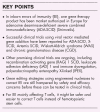Advances in gene therapy for inborn errors of immunity
- PMID: 37846903
- PMCID: PMC10621649
- DOI: 10.1097/ACI.0000000000000952
Advances in gene therapy for inborn errors of immunity
Abstract
Purpose of review: Provide an overview of the landmark accomplishments and state of the art of gene therapy for inborn errors of immunity (IEI).
Recent findings: Three decades after the first clinical application of gene therapy for IEI, there is one market authorized product available, while for several others efficacy has been demonstrated or is currently being tested in ongoing clinical trials. Gene editing approaches using programmable nucleases are being explored preclinically and could be beneficial for genes requiring tightly regulated expression, gain-of-function mutations and dominant-negative mutations.
Summary: Gene therapy by modifying autologous hematopoietic stem cells (HSCs) offers an attractive alternative to allogeneic hematopoietic stem cell transplantation (HSCT), the current standard of care to treat severe IEI. This approach does not require availability of a suitable allogeneic donor and eliminates the risk of graft versus host disease (GvHD). Gene therapy can be attempted by using a viral vector to add a copy of the therapeutic gene (viral gene addition) or by using programmable nucleases (gene editing) to precisely correct mutations, disrupt a gene or introduce an entire copy of a gene at a specific locus. However, gene therapy comes with its own challenges such as safety, therapeutic effectiveness and access. For viral gene addition, a major safety concern is vector-related insertional mutagenesis, although this has been greatly reduced with the introduction of safer vectors. For gene editing, the risk of off-site mutagenesis is a main driver behind the ongoing search for modified nucleases. For both approaches, HSCs have to be manipulated ex vivo, and doing this efficiently without losing stemness remains a challenge, especially for gene editing.
Copyright © 2023 The Author(s). Published by Wolters Kluwer Health, Inc.
Conflict of interest statement
Figures


Similar articles
-
Correcting inborn errors of immunity: From viral mediated gene addition to gene editing.Semin Immunol. 2023 Mar;66:101731. doi: 10.1016/j.smim.2023.101731. Epub 2023 Feb 28. Semin Immunol. 2023. PMID: 36863140 Free PMC article. Review.
-
Precise somatic genome editing for treatment of inborn errors of immunity.Front Immunol. 2022 Aug 26;13:960348. doi: 10.3389/fimmu.2022.960348. eCollection 2022. Front Immunol. 2022. PMID: 36091069 Free PMC article. Review.
-
CD3+TCRαβ/CD19+-Depleted Mismatched Family or Unrelated Donor Salvage Stem Cell Transplantation for Graft Dysfunction in Inborn Errors of Immunity.Transplant Cell Ther. 2023 Aug;29(8):513.e1-513.e9. doi: 10.1016/j.jtct.2023.05.019. Epub 2023 Jun 4. Transplant Cell Ther. 2023. PMID: 37279857
-
Gene Therapy for Inborn Errors of Immunity.J Allergy Clin Immunol Pract. 2023 Jun;11(6):1592-1601. doi: 10.1016/j.jaip.2023.04.001. Epub 2023 Apr 20. J Allergy Clin Immunol Pract. 2023. PMID: 37084938 Review.
-
Gene therapy for primary immunodeficiencies: up-to-date.Expert Opin Biol Ther. 2021 Apr;21(4):529-538. doi: 10.1080/14712598.2021.1837108. Epub 2020 Oct 29. Expert Opin Biol Ther. 2021. PMID: 33078662 Review.
Cited by
-
Safety and efficacy of gene therapy for RAG1-deficient SCID.Mol Ther. 2025 May 7;33(5):1869-1870. doi: 10.1016/j.ymthe.2025.02.044. Epub 2025 Mar 18. Mol Ther. 2025. PMID: 40107272 No abstract available.
-
Failure of metabolic checkpoint control during late-stage granulopoiesis drives neutropenia in reticular dysgenesis.Blood. 2024 Dec 26;144(26):2718-2734. doi: 10.1182/blood.2024024123. Blood. 2024. PMID: 39378586
-
Restoration of T and B Cell Differentiation after RAG1 Gene Transfer in Human RAG1 Defective Hematopoietic Stem Cells.Biomedicines. 2024 Jul 5;12(7):1495. doi: 10.3390/biomedicines12071495. Biomedicines. 2024. PMID: 39062069 Free PMC article.
-
Self-reported Clinical Outcomes and Quality of Life in Agammaglobulinemia: the Importance of an Early Diagnosis.J Clin Immunol. 2025 Aug 25;45(1):125. doi: 10.1007/s10875-025-01904-z. J Clin Immunol. 2025. PMID: 40853601 Free PMC article.
-
Monogenic Inborn Errors of Immunity with impaired IgG response to polysaccharide antigens but normal IgG levels and normal IgG response to protein antigens.Front Pediatr. 2024 Jun 12;12:1386959. doi: 10.3389/fped.2024.1386959. eCollection 2024. Front Pediatr. 2024. PMID: 38933494 Free PMC article. Review.
References
-
- Gatti RA, Meuwissen HJ, Allen HD, et al. . Immunological reconstitution of sex-linked lymphopenic immunological deficiency. Lancet 1968; 2:1366–1369. - PubMed
-
- De Koning J, Van Bekkum DW, Dicke KA, et al. . Transplantation of bone-marrow cells and fetal thymus in an infant with lymphopenic immunological deficiency. Lancet 1969; 1:1223–1227. - PubMed
-
- Hirschhorn R, Yang DR, Puck JM, et al. . Spontaneous in vivo reversion to normal of an inherited mutation in a patient with adenosine deaminase deficiency. Nat Genet 1996; 13:290–295. - PubMed
-
- Stephan V, Wahn V, Le Deist F, et al. . Atypical X-linked severe combined immunodeficiency due to possible spontaneous reversion of the genetic defect in T cells. N Engl J Med 1996; 335:1563–1567. - PubMed
Publication types
MeSH terms
LinkOut - more resources
Full Text Sources
Research Materials

